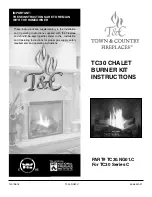
2. APPLIANCE DATA
This product uses fuel effect pieces and a burner compartment rear wall containing
Refractory Ceramic Fibres (RCF), which are man-made vitreous silicate fibres.
Excessive exposure to these materials may cause irritation to eyes, skin and respiratory
tract. Consequently, it is important to take care when handling these articles to ensure
that the release of dust is kept to a minimum. To ensure that the release of fibres from
these RCF articles is kept to a minimum, during installation and servicing we
recommend that you use a HEPA filtered vacuum to remove any dust and soot
accumulated in and around the fire before and after working on the fire. When replacing
these articles we recommend that the replaced items are not broken up, but are sealed
within a heavy duty polythene bag, clearly labelled as RCF waste. This is not classified as
“hazardous waste” and may be disposed of at a tipping site licensed for the disposal of
industrial waste. Protective clothing is not required when handling these articles, but we
recommend you follow the normal hygiene rules of not smoking, eating or drinking in
the work area and always wash your hands before eating or drinking.
This appliance does not contain any component manufactured from asbestos or asbestos
related products.
*
When converted using Kit 0595221
The appliance data label is located on a plate at the base of the fire. This can be seen by
removing the lower trim / firefront and casting.
Page 5
INSTALLER GUIDE
Gas
Natural (G20)
Propane (G31) *
Inlet Pressure
20mbar
37mbar
Input - Max. (Gross)
6.0kW (20,500Btu/h)
6.1kW (20,800Btu/h)
Input - Min. (Gross)
2.3kW (7,850Btu/h)
3.8kW (12,965Btu/h)
Inlet Test Pressure (Cold)
20.0 ± 1.0mbar (8.0 ± 0.4in
w.g.)
37.0 ± 1.0 mbar (14.85 ±
0.4in w.g.)
Gas Connection
8mm pipe
8mm pipe
Burner Injector
Stereomatic Cat 82 - 069
Stereomatic Size 128
Pilot & Atmosphere Sensing
Device
Copreci Ref. O.D.S
21500/166
Copreci Ref. O.D.S
21500/166 Fitted with RBM
180 - 02 injector
Ignition
Piezo Electric. Integral with
Gas Tap
Piezo Electric. Integral with
Gas Tap
Aeration
See section 17.1
Non-adjustable






































